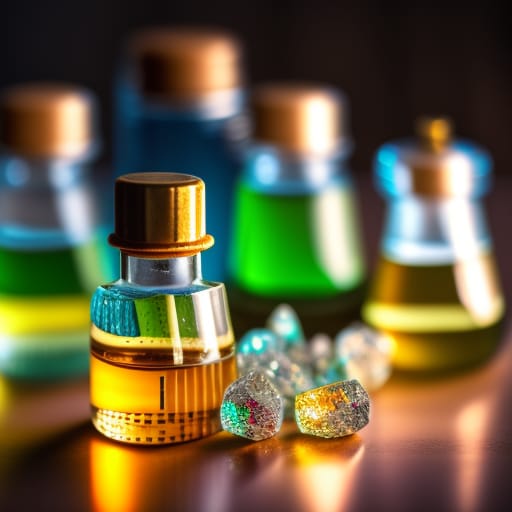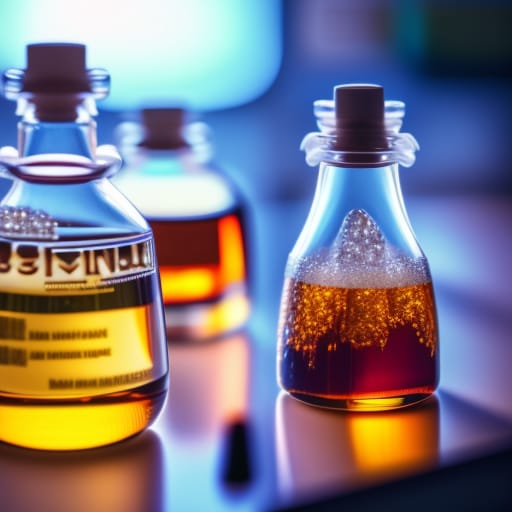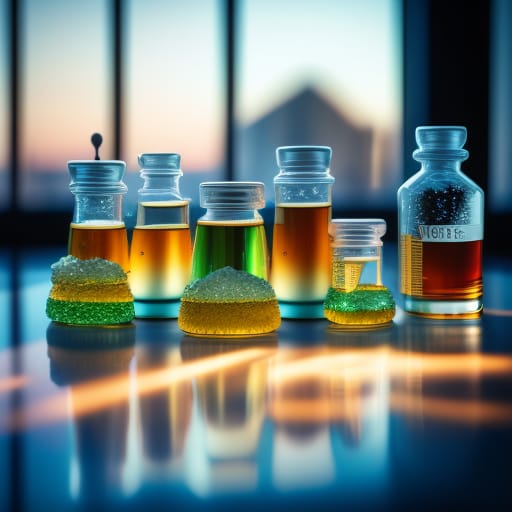Have you ever looked closely at a crystal and marveled at its flawless geometry and rainbow sheen? Crystals are stunning examples of nature’s perfection on a microscopic scale. While crystals take eons to form within the depths of the earth, you can grow your own beautiful crystals at home in a matter of days using a crystal growing kit. But what chemical magic enables these kits to produce picture-perfect crystals on demand? Read on to unlock the secrets behind the mesmerizing crystals formed in crystal growing kits.

What Are Crystal Growing Kits?
Crystal growing kits provide all the materials and step-by-step instructions for growing gorgeous, gleaming crystals at home. Each kit contains a crystal-forming chemical or a combination of chemicals dissolved in a liquid crystal growing solution. By carefully manipulating temperature, saturation levels, and other factors, the dissolved chemical compounds can be coaxed out of the solution and into an orderly crystalline lattice.
Crystal growing kits offer an exciting way for curious kids and adults alike to learn about chemistry and mineral formation through hands-on science experiments and projects. Growing your own crystals is an illuminating lesson in states of matter and particle motion. The kits also yield dazzling crystal ornaments, snowflakes, stars, and other enchanting shapes perfect for seasonal crafts or science fair displays.
Chemicals That Make Crystals Grow
So what exactly causes crystals to sprout from these solutions? There are a variety of chemicals used in crystal growing kits to produce different colors, shapes, and sizes of crystals. Here are some of the most common chemicals for crystal growing:
Salt Compounds
- Borax (sodium tetraborate): Grows large, well-defined crystals. Often combined with laundry bluing for blue crystals.
- Table salt (sodium chloride): Grows cubic crystals.
- Alum (hydrated potassium aluminum sulfate): Grows octahedral crystals. Combines with dye for colored crystals.
- Epsom salt (magnesium sulfate): Grows needle-like crystals.
Mineral Salts
- Copper sulfate: Grows deep blue crystals.
- Nickel sulfate: Grows green/blue crystals.
- Potassium ferricyanide: Grows lemon yellow crystals.
- Sodium thiosulfate: Grows pentagonal, star-shaped crystals.
Other Chemicals
- Ammonium chloride: Grows fern-like crystals.
- Potassium permanganate: Grows dark purple, almost black crystals.
- Sodium carbonate: Grows clear, rhombic crystals.
- Calcium chloride: Grows columnar crystals.
- Sugar (sucrose): Grows sweet rock candy crystals!
The Science Behind Crystal Formation
Now that you know which chemicals can grow crystals, let’s examine the science behind how crystals form from solutions.
Particle Motion and Arrangement
In the crystal growing solution, the particles of the dissolved chemical move freely in a random, disordered manner. As the solution cools and becomes supersaturated, the particles slow down. The overabundant chemical starts to come out of solution and the particles arrange themselves into an orderly lattice structure.
Thermal energy drives the transition from disorder (in the hot, saturated solution) to order (in the cooled, crystalline solid). Removing thermal energy allows the particles to adopt stable positions in the characteristic geometry of a crystal.
Phase Changes: Liquid to Solid
Crystal formation exemplifies phase changes in matter. Within a given temperature range, most pure substances can exist in a solid, liquid, or gaseous state. As a substance cools, its particles lose energy and slow down enough to lock into place in an orderly crystal structure.
Heating the crystal adding thermal energy causes the orderly arrangement to break down as the particles gain enough energy to move freely again. The crystal melts back into a liquid.
States of a Pure Substance
The state that a pure crystalline substance takes depends on its temperature and saturation:
- At high temperatures and under saturation, it forms a liquid solution.
- As temperature drops and saturation rises, it crystallizes into a solid.
- At its melting point temperature, it exists in dynamic equilibrium between solid and liquid states.
- Above the melting point, it returns to a liquid state.
Manipulating these two variables allows crystal growing kits to achieve controlled crystallization.

Growing Crystals Through Experiments
Part of the appeal of crystal growing kits is the ability to learn through hands-on experimentation. Let’s look at some of the classic crystal growing experiments you can try:
Rock Candy
This classic experiment uses everyday household materials to grow delicious sugar crystals:
- Dissolve sugar in boiling water to make a super-saturated solution.
- Add a stick or string as a foundation for crystals to grow on.
- Let the jar sit undisturbed for 5-7 days as large sugar crystals slowly form.
- Enjoy your homemade rock candy!
Copper Sulfate Crystals
This experiment grows deep blue copper sulfate crystals:
- Heat water and stir in copper sulfate powder until no more dissolves.
- Pour the hot saturated solution into a jar.
- Suspend a string in the solution and let the jar cool slowly.
- Brilliant blue crystals will form on the string within a few hours.
Alum Crystals
This experiment produces octahedral alum crystals:
- Boil water in a pot. Stir in alum powder.
- Keep heating the solution until no more alum dissolves.
- Allow the solution to cool undisturbed for a few hours.
- Find perfectly formed alum crystals at the bottom of the pot.
Follow your kit instructions to try out these experiments and grow your own crystalline masterpieces!
The Geology Behind Crystals
The same natural geologic processes that form sparkling crystals over eons in the earth’s crust are replicated on a smaller scale in crystal growing kits. An understanding of basic geology helps shed light on crystal formation.
Mineral Structure
Crystals are structured arrangements of ions or molecules repeating in three dimensions. The various shapes reflect the internal crystalline structure. For example, halite’s cubic shape reflects its underlying cube-shaped lattice.
Crystallization Process
Natural crystal formation starts when minerals precipitate out of an aqueous solution, usually due to cooling. Slow precipitation allows the ions to align into ordered structures. Fast precipitation leads to disorderly, amorphous solids.
Hydrothermal Solutions
Hot water circulating through rock dissolves minerals. As the heated solution rises and cools, the minerals crystallize. Many gems, like amethyst, crystallize from hydrothermal solutions.
Sedimentary Conditions
Evaporation of seawater leaves layered deposits of dissolved minerals which accumulate as crystals. The giant selenite crystals of Naica Cave in Mexico formed this way.
Metamorphic Environments
Pre-existing minerals recrystallize under heat and pressure, resulting in new crystalline structures. For example, graphite converts to diamond through metamorphism.

Choosing a Crystal Growing Kit
If you’re ready to start growing your own crystals at home, there are many excellent crystal growing kits to choose from. Here are some top recommendations:
Geode Kits
- National Geographic Break-Open Geodes – $25 for 12 geodes. Cracked open to reveal real amethyst, citrine, or quartz crystals.
- Dan&Darci Crystal Growing Lab – $27. Features crystals growing within fragile geode eggs.
Advanced Crystal Kits
- Home Science Tools Crystal Growth Lab Kit – $42. Grows 6 types of quality crystals with detailed lessons.
- Thames & Kosmos Crystal Science Kit – $30. Grow rainbow-colored crystals using borax and starch.
Beginner & Kids Kits
- 4M Crystal Growing Experiment – $15. A simple kit for growing a single blue crystal geode. Best for ages 8+.
- Melissa & Doug Crystal Creations Crystal Stars Set – $20. Grow magically colored crystal stars. Great for kids ages 6+.
- QQJ Crystals for Kids – $22 for 8-pack. Grow crystals in test tubes for a cool science project. Ideal for ages 5-9.
Be sure to consider the child’s age and scientific aptitude when selecting a crystal growing kit. Advanced kits with caustic chemicals are unsafe for younger children. Under supervision, crystal growing engages kids of all ages in the joys of experimental science.
Grow On: Additional Resources
To take your crystal growing to the next level, reference additional resources:
- Illinois State Geological Survey – Background on crystal formation with experiments.
- Royal Society of Chemistry – Lesson plans and activities about crystals.
- Fortey’s Top 10 Crystals – Information on geological crystals from the Natural History Museum.
- How to Grow Great Crystals – Tips for growing quality crystals at home.
Conclusion: The Precise Magic of Crystals
As you’ve learned, the mesmerizing crystals grown in kits rely on the precise chemical properties of the dissolved compounds. By manipulating temperature, saturation, purity, and growth rate, the molecules neatly align into orderly geometric arrangements. Each substance crystallizes into unique and predictable shapes governed by its atomic lattice structure. Mastering the chemistry and geology involved in crystal formation allows you to reliably create these enchanting structures in your own kitchen! When you gaze at the flawless symmetry and kaleidoscopic splendor of your homemade crystals, you’ll see firsthand the meticulous molecular order underlying their growth.
Frequently Asked Questions
What are the best chemicals for crystal growing for beginners?
Some good beginner chemicals are borax, table salt, alum powder, Epsom salt, and sugar. These are inexpensive and readily available household items that produce quality crystals. Start with classics like rock candy or copper sulfate crystals.
How can I make colored crystals with a kit?
Add food coloring or liquid watercolors to the hot saturated chemical solution to tint the crystals. Alum powder can be dyed to produce vibrant crystals. Or find a kit formulated to grow preset colors like rainbow crystals.
What shapes and sizes of crystals can I grow?
The shape and size depend on the chemical. Table salt and borax form cubic crystals while alum grows octahedrons. Copper sulfate makes elongated prismatic crystals. Let crystals grow undisturbed for days to reach maximum size.
Can I speed up crystal growth for science fair projects?
Growing large crystals takes patience. However you can accelerate the process by using higher saturation levels and large seed crystals. Gently shake or tap solutions to stimulate growth. Maintain optimal warm temperatures around 105°F.
Is it safe for kids to do crystal growing experiments?
Many kits designed for children 8+ use mild borax solutions. Other chemicals like potassium permanganate or copper sulfate can irritate skin and should be handled carefully under adult supervision. Follow all safety precautions.